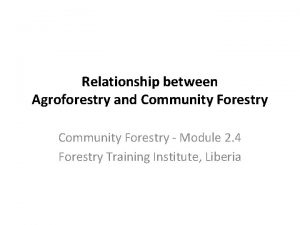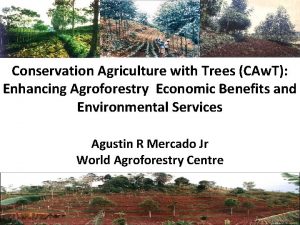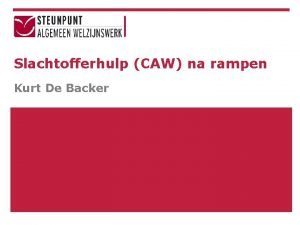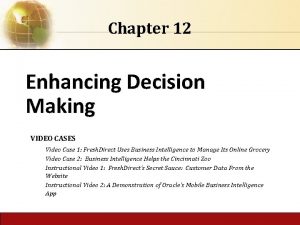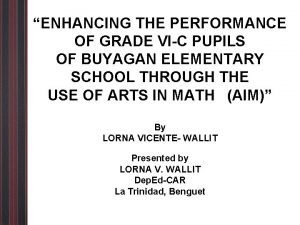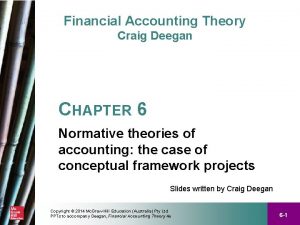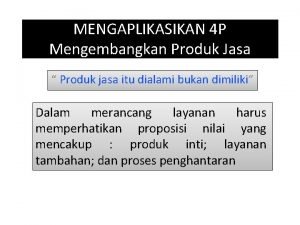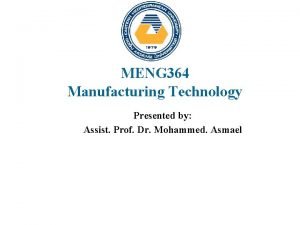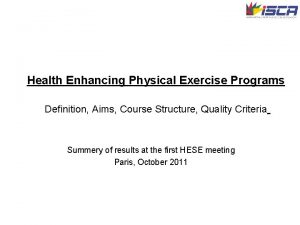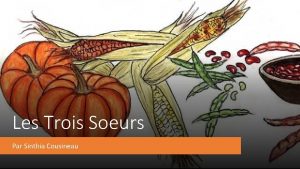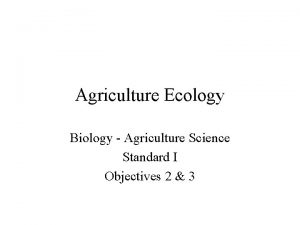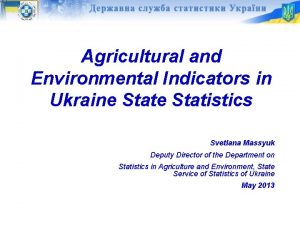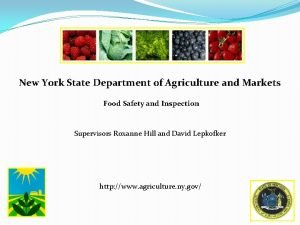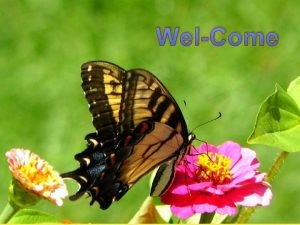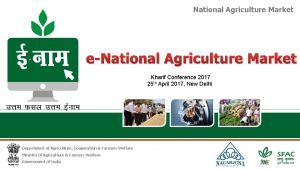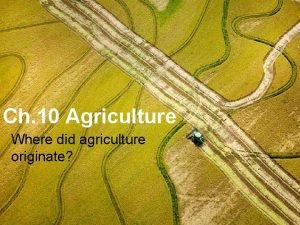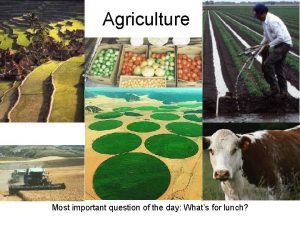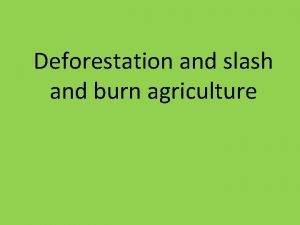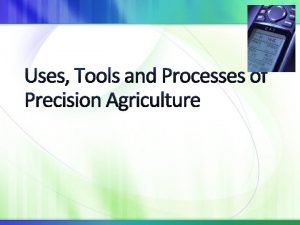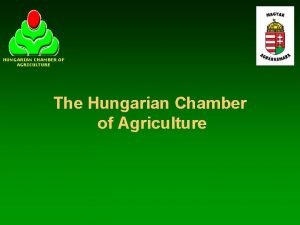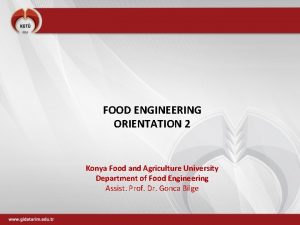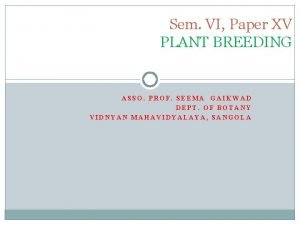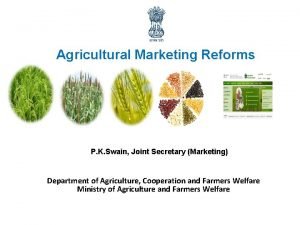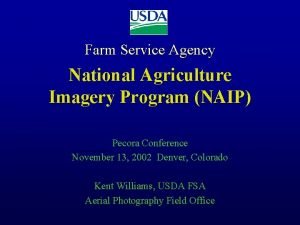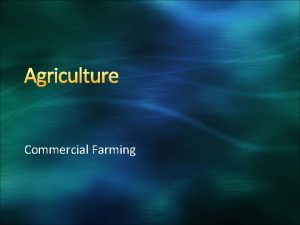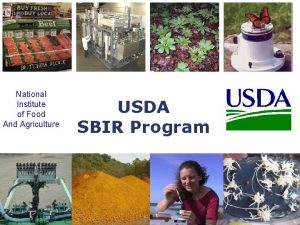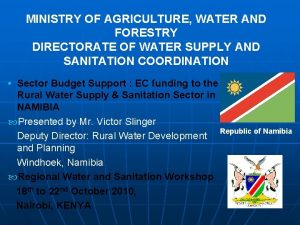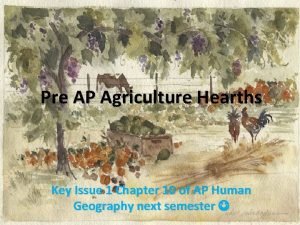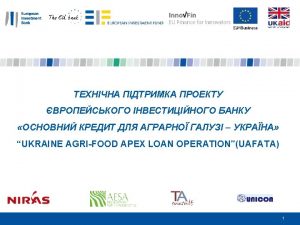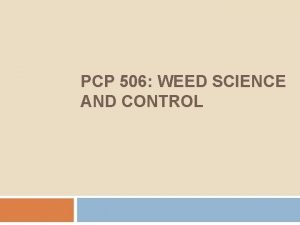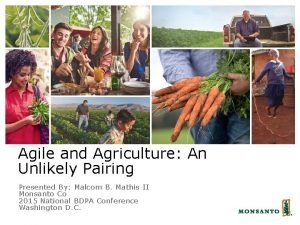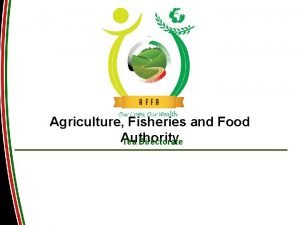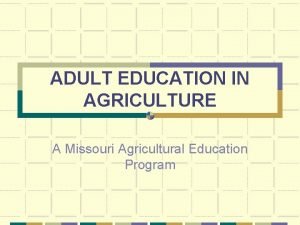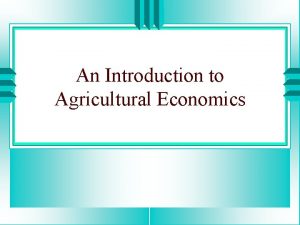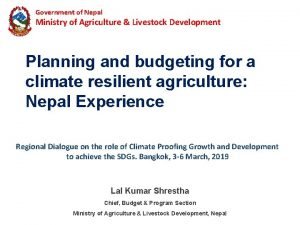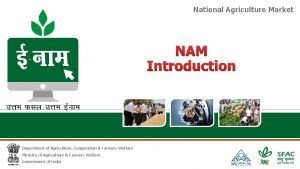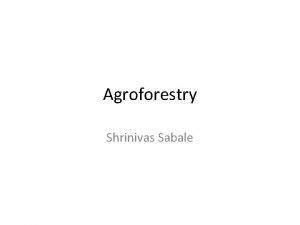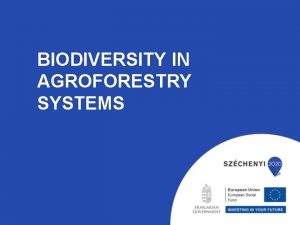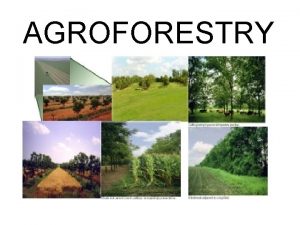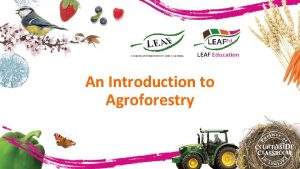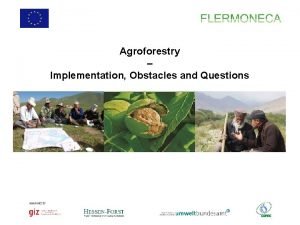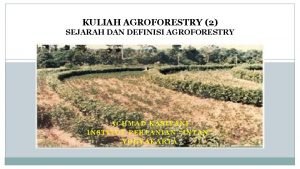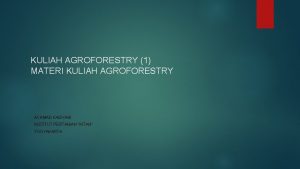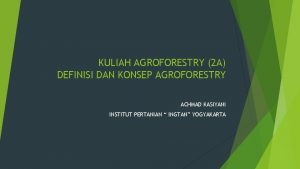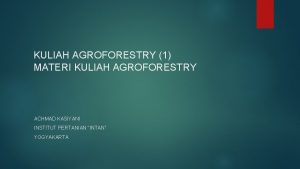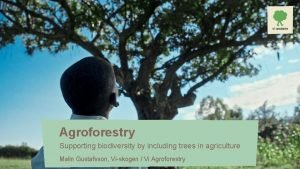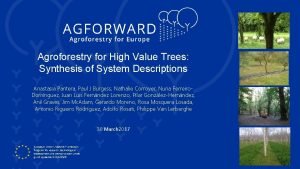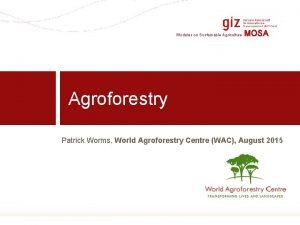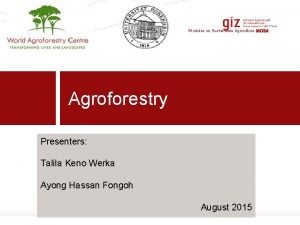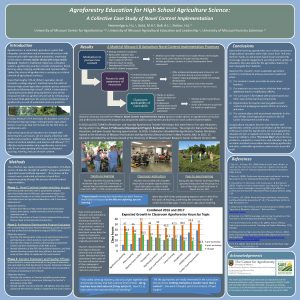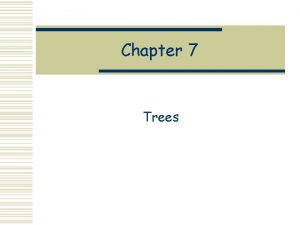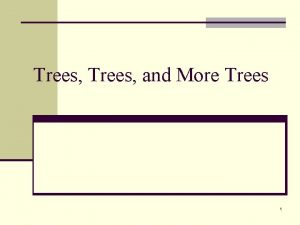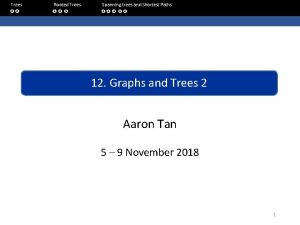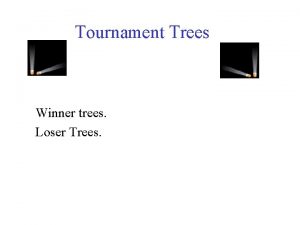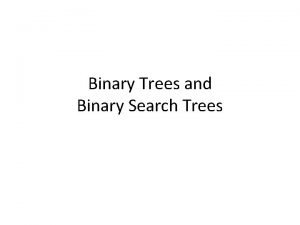Conservation Agriculture with Trees CAw T Enhancing Agroforestry






















































- Slides: 54

Conservation Agriculture with Trees (CAw. T): Enhancing Agroforestry Economic Benefits and Environmental Services Agustin R Mercado Jr World Agroforestry Centre

Outline of the Talk • Agroforestry and its benefits • Implementation of agroforestry through “Conservation Agriculture with Trees on Slopes” (Sloping Land Management) • Ways on improving the benefits of agroforestry on sloping lands • Summary

ICRAF Mindanao Staff • • • Agustin R. Mercado, Jr. – Site Coordinator Caroline Duque-Pinon – RUPES Don Immanuel Edralin - SANREM Jesusa Rafinan – Admin Officer Hernane. Franje – Admin Support 12 daily paid field workers

ICRAF-Philippines R&D Themes • • Trees and tree-seed systems Conservation farming and agroforestry Community-based NRM (i. e. , Landcare) Climate change and environmental services

Claveria Research Site Cagayan de Oro city Claveria • only land-locked municipality of Misamis Oriental • Consist of 24 barangays/villages • Land area of 82, 500 has • Population of 48, 000

Claveria, Misamis Oriental • elevation ranges from 450 to 1200 meters above sea level • maize, cassava and upland rice cropping dominate the lower elevation (<600 masl), while vegetable and maize in rotation dominate the upper elevation. • landscape is derived from pyroclastic materials. Soils are deep, fine mixed isohyperthermic Ultic Haplorthox • Soils are acidic with p. H ranges from 4. 2 to 5. 2. • Rainfall is 2500 mm well distributed throughout the year. • Farm sizes range from 0. 25 to 5. 0 ha, averaging 2. 0 ha. • Represents 10 M hectares in the Philippines; 181 M in Southeast Asia

Challenges in the uplands Soils are inherently acidic and poor Inappropriate farming practices Soil erosion is high Declining farm productivity Declining farm size due population pressure • Deforestation in upper watersheds • Upper watersheds of lowland communities and cities impacting the lives and livelihoods of people living down stream • • •

Upland areas can be highly productive

Enhancing agroforestry benefits environmental services and community resilience to changing climate in the uplands Overall hypothesis In tree-depleted upland areas with poor soils and risks prone environments, farming systems purely based on annual food crops are not sustainable, but diversified tree-based farming systems are feasible and offer better prospects.

Conservation Agriculture with Trees (CAw. T) on Slopes CAw. T on slopes is a dynamic and ecologically based sustainable land management system that diversifies and increases production, while simultaneously promoting social, economic and environmental services for all land users

5 Important principles of CAw. T • Integration of trees • Minimal soil disturbance • Continuous mulch or ground cover • Diverse crop species • Integrated nutrient and pest management

Context of Conservation Agriculture Flat lands: >100 M hectares Brazil, Cambodia and other places Sloping lands: Philippines (10 M ha); DPRK ?

In the context of sloping lands, there’s a need for deliberate integration of trees. . .

Agroforestry definition • An approach to land use in which woody perennial (trees, shrubs, palms, bamboos) are deliberately grown on the same land management unit as agricultural crops and/or animals, either on some form of spatial arrangement or temporal sequence. In agroforestry systems, there are both environmental and economic interactions between the different components” (Lundgren and Raintree, 1983)

Forestry Agroforestry systems Agriculture

Agroforestry = agriculture + forestry • Agroforestry = crops + animals + trees – grown separately (spatial or temporal) – grown simultaneously) (trees + crops or animals) with environmental (ecological) and economic interactions /benefits to address: – – – poverty (increase income) food security (subsistence farming) land degradation/ degraded soils shortage of fodder, fuel, constructions materials etc lack of capital Deforestation

Key Attributes of AF Systems • Maintain or enhance productivity (economic benefits) • Maintain or enhance environmental quality (environmental services) • Be acceptable to local farmers and communities (social benefits) 17

AF Environmental services a) Soil conservation/soil amelioration • • • Prevents or minimize soil erosion (roots and stem serve as physical barriers); High organic matter (serve as buffer against rainfall impact; increases soil aggregation/infiltration) Serves as wind breaks (protection against windinduced erosion); Litter falls (source of nutrients); Improves soil properties (efficient nutrient cycling/nutrient pump, symbiotic associates with beneficial microorganism, improves soil porosity, infiltration rate and structure).

AF Environmental Services b) Water conservation • Increase soil porosity and infiltration; • Increase water retaining capacity (organic matter/litter and crown shade minimize soil moisture evaporation, organic matter acts as “sponge” or mulch).

AF Environmental Services … c) Microclimate amelioration • Shading effect, lower temperature, less air turbulence; • Less intense solar radiation, dampens environmental fluctuations; • Favorable soil environment for earthworms and other organisms d) Other benefits • Enhance aesthetics and landscape beauty; • Provide food and shelter for wildlife; • Bio-diversed structure prevents pest and disease epidemics

2. Socio-Economic Benefits of AF • • Source of food Fuelwood Fodder Timber and other raw materials for buildings Handicraft/cottage industries, Source of employment/income Carbon stocks (tradable) Other tradable environmental services

Agri-silvipastoral system

Rubber agroforestry system (RAS) on slopes Rubber Banana Durian or other fruit trees Maize/upland rice/vegetable 10 meters Forage grasses and legumes 20 meters

Examples of Environmental benefits of AF

Biomass and carbon stocks of rubber trees as influenced by different density of planting simulated using Se. Xi- FS model. Claveria, Misamis Oriental SEx. I-FS – Spatially explicit Individual-based Forest Simulator developed by World Agroforestry Centre, Bogor, Indonesia.

Latex yield and income of rubber as influenced by spacing simulated using Se. Xi-FS model. Claveria, Misamis Oriental Note: Latex yield and price are expressed in dry rubber

Total carbon stocks (t/ha) of different systems at 12 years in comparison with corn continuous cropping.

CAw. T: Good practices 1) Natural vegetative filter strips establishment Establishment of natural vegetative filter strips along contour lines is the initial and simple low cost conservation measure allowing natural vegetation to grow at 50 -cm width strips spaced at 8 -10 meters apart to effectively protect the soil from erosion. NVS systems provide foundation for the establishment of cash perennials on the contour strips.

CAw. T: Good practices 2) Cash perennials integration and improved cropping pattern Cash perennials such as rubber, timber and fruit trees including bananas, forage grasses and legumes established as enrichment from NVS provide farm agridiversity and income. High root length densities of banana, creeping forage legumes and grasses provide soil binding function, and tree roots provide soil anchorage which will protect sloping lands against landslide. Crop rotation of vegetables, maize, upland rice and grain legumes reduces pest and diseases and enhances fertilizer use efficiency. Integration of upland rice complements lowland rice production and addresses Philippine self- sufficiency in rice.

CAw. T: Good practices 3) Timber- and fruit- based agroforestry Inclusion of timber trees enhances farming system diversity and profit as well as the capacity to sequester carbon. Integration of upland rice, maize and cowpea into the tree based system promotes food security. Moreover, the inclusion of N 2 -fixing grain legumes increases sustainability in the productivity of upland soils.

CAw. T: Good practices 4) Vegetable agroforestry Properly managed trees improve vegetable yields up to 40% as a result of having a desirable microclimate with low wind speed, increased relative humidity, high soil moisture and soil organic matter content. Trees also provide environmental services such as habitat for wildlife, control for soil erosion and carbon sequestration for climate change apart from providing additional nutrients to crops through N 2 -fixation

CAw. T: Good practices 5) Livestock integration Livestocks, such as cattle, goats, pigs, chicken and ducks, can provide additional income, food (meat and milk), draft power and manure. Animal manures can be useful for biogas for the household energy requirement as well as substrate for vermicomposting. The integration of livestock into the farm increases farm agri-diversity and risk management strategy for climate change.

CAw. T: Good practices 6) Rainwater harvesting addresses rainfall variability during climate change making water available to crops as well as to livestocks during dry spells. It increases water infiltration thus providing subsurface irrigation to perennial crops. It also provides additional income to farmers by having fish, frog and duck culture. Raising fish, frogs and ducks, while increasing farmers income, will improve nutrient loads to the pond water which will improve crop growth if used for irrigation.

CAw. T: Good practices 7) Organic fertilizer production Organic fertilizer like vermicomposting is important in addressing Farmers’ fertilizer requirements. The use of organic fertilizers increases soil organic matter (OM) improving soil moisture during drought thus making a suitable growing environment for crops. Its use also mitigates climate change through avoiding CO 2 emission through fertilizer substitution from the use of inorganic fertilizers, injection of carbon into the soil and potential of mass participation of smallholders to climate change mitigation.

CAw. T: Good practices 8) Minimum tillage, mulch and cover crops Minimum tillage, mulch and cover crop maintain soil cover throughout the year which reduce soil erosion, increase water infiltration, reduce weed pressures and improve soil fertility. They also improve soil carbon thus help mitigate climate change. Cover crop like Arachis pintoi provides nitrogen and renders phosphorus available to the associated crops.

Typical tree- crop interaction

Agroforestry system

4 Ways of Improving Economic Benefit of Agroforestry System 1. Increase the value of trees (T) 2. Increase the value of complementarity (Y 2) 3. Decrease or eliminate competition value (Y 1) 4. Decrease or eliminate the value of crop displacement area (D)

Increasing the value of T (Trees) (1) • Optimize vertical use of aboveground resources (space and light) by using multi-canopy levels hedgerow systems (e. g. trees + banana + grasses) • Optimize use of vertical and horizontal belowground resources (space, water and nutrients) by using deep rooted indigenous trees) • Optimize use of inert resources such as air and CO 2 by using N 2 fixing trees (e. g. Acacia mangium, Narra Pterocarpus indicus and fast growing trees (e. g lauaan for timber and carbon sequestration) • Choose trees with premium products like quality timber, latex or fruits.

Increasing the value of Y 2 (2) (complementarity zone) through the use of: • Optimum tree line/ hedge spacing (20 -25 m) • Responsive alley crops to micro-climate improvement • Deep-rooted hedgerow species • Optimum tree pruning regime (silviculture) • Appropriate tree species or other hedgerow species (less competitive)

Decreasing the value of Y 1 (3) (competition zone) through the use of: • Adapted alleycrops (cassava vs maize) • Appropriate tree species – Medium to narrow and light canopies – Deep rooted – N 2 -fixing (if possible) • Appropriate tree pruning regime (canopy removal and timing) • Supplemental water and nutrient application at competition zone (e. g. skewing the application of prunnings and fertilizer, application of drip irrigation) • Orient the tree rows parallel to the direction of the sun (eastwest if possible)

Decreasing or eliminating the value of D (crop displacement area) (4) • Ensure that the value of T is greater than opportunity cost of D • Use of early maturing hedges in combination with indigenous trees (clonally propagated trees: rubber, coffee, timber and fruit trees (marcotting vs grafting; use of rooting hormones (IBA, ANAA, etc); forage grasses and legumes • Reduce the displacement area by having fewer hedges (e. g. 20 meters instead of 5 -6 meters apart) thus enhancing AF complementarity effect

Percent yield increase of vegetables under tree based system Dry season (Feb – May) Average Chinese cabbage 37 30 34 Cabbage 13 0 7 Tomato 40 10 25 Bell pepper 20 10 15 Carrots 37 30 34 Mean 29 16 18 Vegetables Wet season (June – Sept)

20 m CAPS Schematic diagram of single tree-line agroforestry system

CAPS 20 m CAPS Schematic diagram of double -tree line agroforestry system

20 m 30 cm 90 cm maize cowpea 90 cm 30 cm Single Tree-Line Conservation Agriculture Production System with Trees (CAPST)

Conservation Agriculture Production System with Trees 20 m Legume (Cowpea) + Maize Single Tree-Line Conservation Agriculture Production System with Trees (CAPST)

Maize + Cowpea - Upland rice + Cowpea Cropping Pattern

Conservation Agriculture Production System with Trees 20 m Maize + Arachis pintoi (Cover crop) Single Tree-Line Conservation Agriculture Production System with Trees (CAPST)

Conservation Agriculture Production System with Trees 20 m Maize+Stylo Maize + Stylosanthes – Maize+Stylo fallow Stylosanthes alone – Maize alone Single Tree-Line Conservation Agriculture Production System with Trees (CAPST)

Conservation Agriculture Production System with Trees Older Than 3 Years Old 20 m 10 -20 m maize cowpea 5 m 5 m Single Tree-Line Conservation Agriculture Production System with Trees (CAPST)

Double tree-line conservation agriculture Fruit/ Timber trees production system (CAPS) with. Rubber/ Trees Maize + Cowpea – Upland rice + cowpea maize cowpea 2 m 30 cm 20 m x 2 m x 3 m; 30 m x 2 m x 3 m

Summary Agroforestry provides environmental services and socio-economic benefits • CAw. T on slopes in the context of agroforestry is a delivery mechanism for multi-functional agriculture (MFA) and landscapes • Better ways of managing agroforestry systems enhance environmental services and socio-economic benefits and make agroforestry more acceptable to farmers •

Thank you very much! Acknowledgement and Contact Thank you organizers of this Reward for Environmental Services (RES) Forum in Mindanao. Agustin R. Mercado, Jr. . Ph. D World Agroforestry Centre Claveria Research Site, MOSCAT Campus, Claveria, Misamis Oriental, 9004 Philippines agustin 9146@yahoo. com
 Difference between agroforestry and community forestry
Difference between agroforestry and community forestry Economic benefits of agroforestry
Economic benefits of agroforestry Caw slachtofferhulp
Caw slachtofferhulp Babbeldoos
Babbeldoos Mindspring
Mindspring Oviposition
Oviposition Enhancing professional practice a framework for teaching
Enhancing professional practice a framework for teaching Danielson 3c look fors
Danielson 3c look fors Enhancing decision making
Enhancing decision making Enhancing the performance of grade vi-c
Enhancing the performance of grade vi-c Enhancing decision making
Enhancing decision making Enhancing personal effectiveness
Enhancing personal effectiveness Privacy-enhancing computation
Privacy-enhancing computation Four enhancing qualitative characteristics
Four enhancing qualitative characteristics History of performance enhancing drugs
History of performance enhancing drugs Enhancing supplementary services
Enhancing supplementary services Text box formatting
Text box formatting Explain property enhancing operations
Explain property enhancing operations Enhancing professional practice
Enhancing professional practice Health enhancing physical activity definition
Health enhancing physical activity definition Enhancing thermal conductivity of fluids with nanoparticles
Enhancing thermal conductivity of fluids with nanoparticles Les 3 soeurs agriculture
Les 3 soeurs agriculture Biology and agriculture
Biology and agriculture Application of statistics in agriculture
Application of statistics in agriculture Hunters and gatherers
Hunters and gatherers Article 20-c food processing license
Article 20-c food processing license Agriculture quality management
Agriculture quality management Ministry of agriculture slovenia
Ministry of agriculture slovenia National agriculture market
National agriculture market What is agriculture
What is agriculture Whats shifting cultivation
Whats shifting cultivation Introduction of sustainable agriculture
Introduction of sustainable agriculture Definition of slash and burn
Definition of slash and burn Precision farming definition
Precision farming definition Hungarian chamber of agriculture
Hungarian chamber of agriculture Konya food and agriculture university
Konya food and agriculture university Plant breeding objectives
Plant breeding objectives P k swain
P k swain National agriculture imagery program
National agriculture imagery program Commercial farming definition
Commercial farming definition Usda sbir
Usda sbir Nmsa guidelines
Nmsa guidelines Ministry of agriculture, water and forestry directorates
Ministry of agriculture, water and forestry directorates Agricultural hearth map
Agricultural hearth map Department of agriculture
Department of agriculture Introduction to smart agriculture
Introduction to smart agriculture Slove
Slove Weed eradication definition
Weed eradication definition Florida dept of agriculture and consumer services
Florida dept of agriculture and consumer services Agile agriculture
Agile agriculture Tea directorate
Tea directorate Dese agriculture education
Dese agriculture education Importance of economics in agriculture
Importance of economics in agriculture Ministry of agriculture and livestock development nepal
Ministry of agriculture and livestock development nepal Department of agriculture
Department of agriculture
